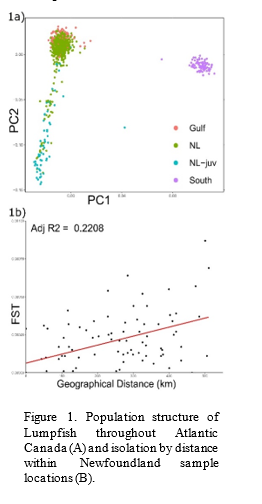DISTINCT SPATIAL GENOMIC STRUCTURE OF LUMPFISH Cyclopterus lumpus ACROSS THE NORTHWEST ATLANTIC
Lumpfish, Cycloterus lumpus, have historically been harvested throughout Atlantic Canada but are also increasingly in demand as an alternative solution to controlling sea lice in North Atlantic salmon farms - a process which involves both the domestication and the transfer of individuals between geographic regions. However, little is known regarding population structure of wild Lumpfish, restricting attempts to assess the potential impacts of escaped Lumpfish used in salmon aquaculture on wild populations. Here, our goal was to characterize the spatial structure of wild populations of Lumpfish throughout the Northwest Atlantic, with a specific focus on the waters around Newfoundland.
We obtained both 70K SNP array data and whole genome sequence data (WGS) for samples from Newfoundland (N=874, NL), the Gulf of Saint Lawrence (N=107, Gulf), Nova Scotia (N=13, NS), and Maine, USA (N=70). Our results suggest that at broad spatial scales, the southern populations (Maine and NS) were highly differentiated from more northern populations (NL and the Gulf; Fig 1a), and that this break was environmentally associated and consistent with adaptive differences. At finer spatial scales, our results suggest two distinct groups in the north, one that encompassed the majority of NL and all the Gulf, and the other which encompassed predominately juveniles caught inshore NL (some adults were present as well, Fig 1a). There was also evidence of subtle structure within the NL regional group, with significant genetic isolation by distance (fig 1b) and environmentally associated structure detected.
This study represents the first description of population structure within Lumpfish in Atlantic Canada, revealing evidence of broad and fine geographic scale genomic and likely adaptive diversity in this species. These results directly inform the use of Lumpfish as a cleaner fish in Atlantic Salmon aquaculture and the conservation of this at-risk species throughout Atlantic Canada.
